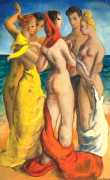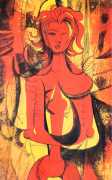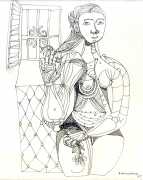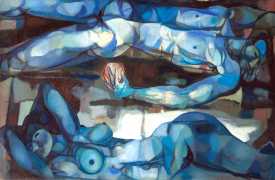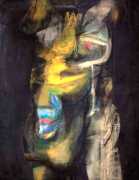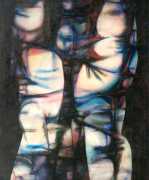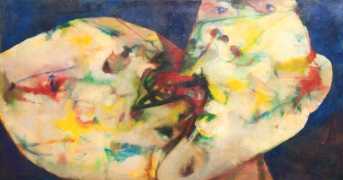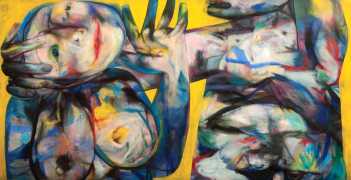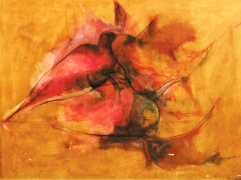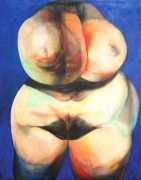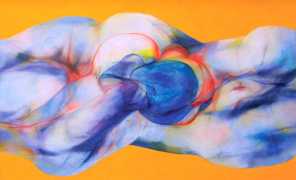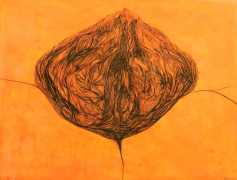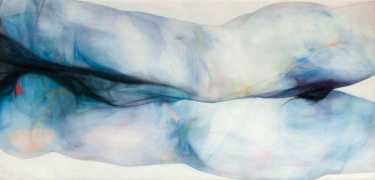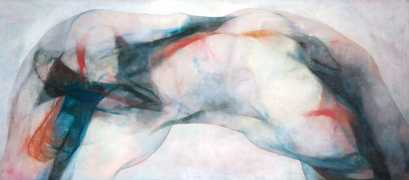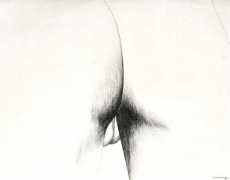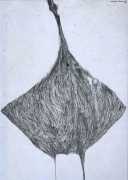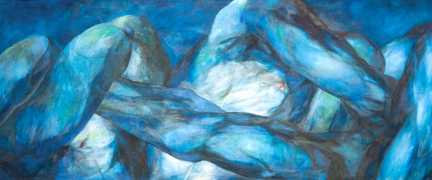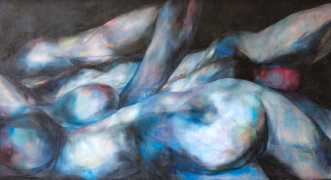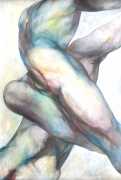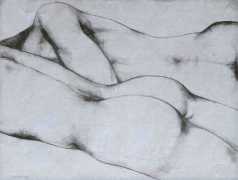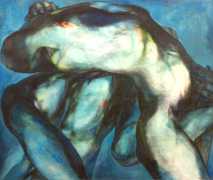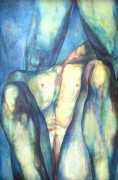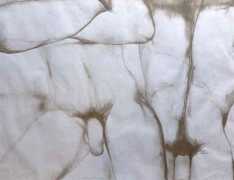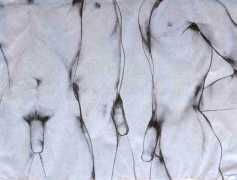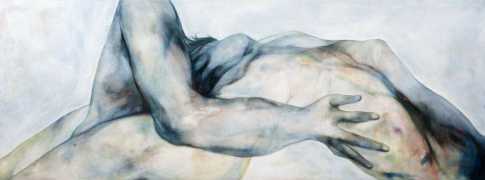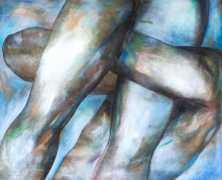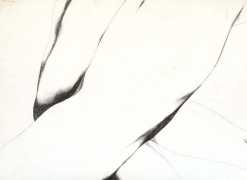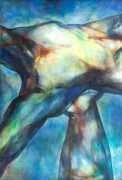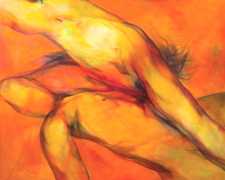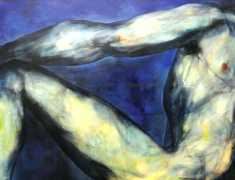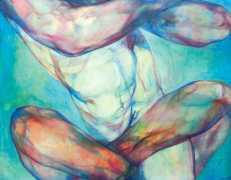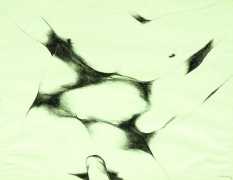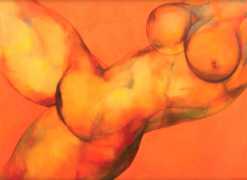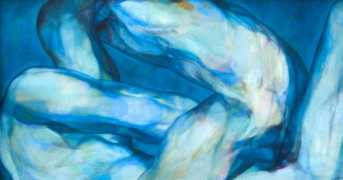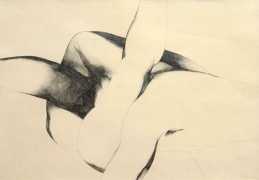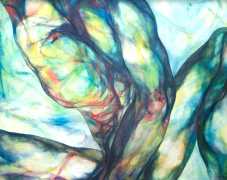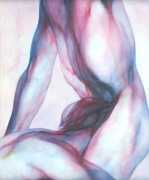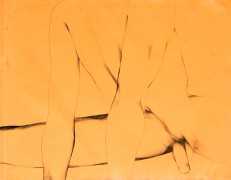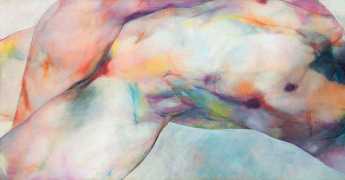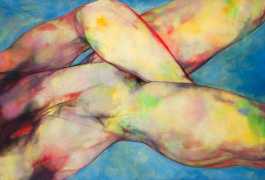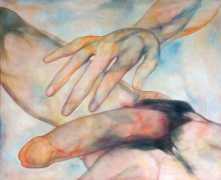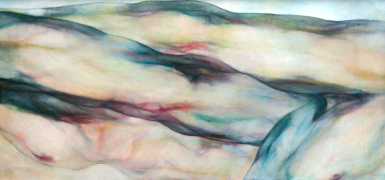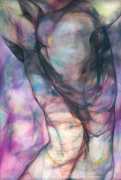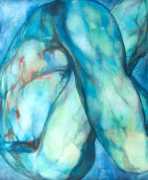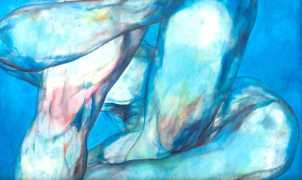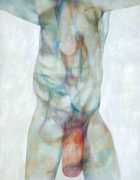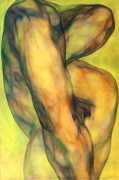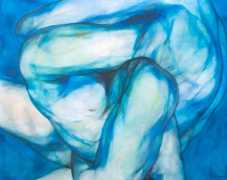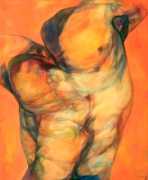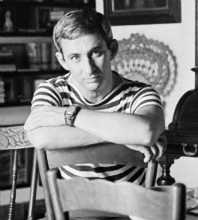 Nearly all of the paintings shown here are from the highly productive period from 1970 to 1981; Servando Cabrera Moreno continued to paint his large sensual canvases right up to his death, though the titles of many of the later works – A Quién le Importa (Who Cares), Cuando el Aire Tiembla (When Air Trembles), El Largo Camino de las Nostalgias (The Long Path of Nostalgia), El Silencio y la Esperanza (Silence and Hope), La Conciencia de Ser Yo (The Awareness of Being Myself), and La Fuente de la Vida (The Source of Life) – hint at some larger existential purpose and vision.
Nearly all of the paintings shown here are from the highly productive period from 1970 to 1981; Servando Cabrera Moreno continued to paint his large sensual canvases right up to his death, though the titles of many of the later works – A Quién le Importa (Who Cares), Cuando el Aire Tiembla (When Air Trembles), El Largo Camino de las Nostalgias (The Long Path of Nostalgia), El Silencio y la Esperanza (Silence and Hope), La Conciencia de Ser Yo (The Awareness of Being Myself), and La Fuente de la Vida (The Source of Life) – hint at some larger existential purpose and vision.
The first few paintings show him in his folk art and Picasso phase, though it is clear that already in the mid-1960s he was experimenting with a looser technique to explore body forms. By La Cordillera (The Mountain Range) in 1972, where intertwined blue limbs can just as easily be read as a landscape, his trademark style of portraying the skinscape of human bodies is established.
Here are the titles and dates of all the paintings shown:
Playa (Beach), 1948
Amalia, 1959
Mujer ante la Ventana (Woman at the Window), 1959
Palmar, 1963
El Fruto (Fruit), 1964
Columna Humana (Human Column), 1965
Columna Humana No 7 (Human Column No 7), 1965
Personaje II (Persona II), 1965
Untitled, 1965
Beso 11 (Kiss 11), 1966
Beso 5 (Kiss 5), 1966
La Entrada (The Entrance), 1966
Cuestionario (Questionnaire), 1967
Beso (Kiss), 1968
El Sacrificio (The Sacrifice), 1968
Estela,1969
Los Géminis no Tienen Tiempo (Geminis don’t have Time), 1969
Untitled, 1969
El Silencio (The Silence), 1970
Saludos Eternos para Sevilla (Eternal Greetings to Seville), 1970
Con Plomo en la Sangre (With Lead in the Blood), 1971
Untitled, 1971
Untitled, 1971
La Cordillera (The Mountain Range), 1972
Muerte e Vita (Death and Life), 1972
Otra vez Sevilla (Seville Again), 1972
El Apolo de Luyanó (The Apollo from Luyanó), 1974
El Moncada (The Moncada), 1974
La Toma del Cuerpo por un Cubano (Body Study by a Cuban), 1974
Toda la Pintura (All the Painting), 1974
Y Sevilla! (And Seville!), 1974
Amistad (Friendship), 1975
Los Mejores Dias de Nuestro Año (The Best Days of our Year), 1975
Prólogo sin Palabras (Prologue without Words), 1975
Sevilla y el Tiempo (Seville and the Times). 1975
La Trinchera de Caná (The Trench of Caná), 1976
Nuestros Isleños (Our Islanders), 1976
Sevilla siempre Sevilla (Seville Always Seville), 1976
Yo Quiero (I want), 1976
Como un Veintiocho de Mayo (As a May Twenty-Eighth), 1977
Estoy Contento (I Am Happy), 1977
La Antorcha (The Torch), 1977
La Memoria de los Borrados (Remembrance of Erased Memories), 1977
Las Hojas de Otoño Caen en la Meseta (Autumn Leaves Falling on the Table), 1977
Vuelve Sevilla (Seville Returns), 1978
Amor Joven y Desconocida (Young and Unknown Love), 1979
El dios de Menta (The God of Mint), 1979
La Joven Pintura (Young Painting), 1979
La Pagoda (The Pagoda), 1979
Llego Tarde para el Mundo (I am Late for the World), 1979
Mayo Incita y Apena (May Provokes and Distresses), 1979
Parte del Tiempo Amado (Part of the Time Beloved), 1979
Sevilla en el Horizonte (Seville on the Horizon), 1979
Tientas, 1979
Untitled, 1979
Arenal de Sevilla, 1980
El Lecho Libio (The Warm Bed), 1980
Mucho más Temprano que Tarde (Much Earlier than Later), 1980
A quién le Importa (Who Cares), 1981
Cuando el Aire Tiembla (When Air Trembles), 1981
El Largo Camino de las Nostalgias (The Long Path of Nostalgia), 1981
El Silencio y la Esperanza (Silence and Hope), 1981
El Vaivén de las Luces Violetas (Violet Lights Come and Go), 1981
La Conciencia de Ser Yo (The Awareness of Being Myself), 1981
La Fuente de la Vida (The Source of Life), 1981
La Soledad y Sevilla (Solitude and Seville), 1981
Lo que nos Pertenece (What Belongs to Us), 1981
Macho Puro (Pure Macho), 1981
Mayo de Todas los Flores (May in Flower), 1981
Rómulo y Remo (Romulus and Remus), 1981
Una Bandeja para Bautista (A Platter for Bautista), 1981


